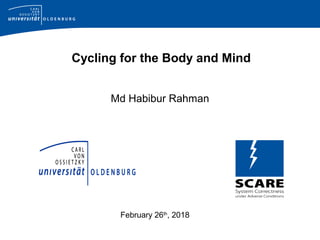Cycling for the body and mind
- 1. Cycling for the Body and Mind Md Habibur Rahman February 26th , 2018
- 2. Structure of Presentation ŌĆó Motivation ŌĆó Key questions ŌĆó Introduction ŌĆó Benefits of cycling ŌĆó Cycling in adverse conditions ŌĆó Bicycle safety ŌĆó What needs to change? ŌĆó Conclusion
- 3. Motivation Lack of sustainable urban travel
- 4. Key Questions ŌĆó Why Cycling? ŌĆō Cycling is specifically beneficial because itŌĆÖs transportation and a work-out rolled into one! ŌĆó Why Do Active Transportation? - Bike ŌĆō Healthier employees = Increased productivity ŌĆō Reduced employee demand for parking ŌĆō Improved accessibility to worksite ŌĆō less congestion
- 5. Introduction ŌĆó The first bicycle titled ŌĆ£The walking machineŌĆØ. ŌĆó It was invented by Baron von Drais in 1817. ŌĆó The pedals were added in 1865. ŌĆó This machine was called Velocipede or Boneshaker The Walking Machine, 1817
- 6. Introduction (cont.) High-wheeled bicycle in 1870 High-Wheeled Tricycle in 1880
- 7. Introduction (cont.) 1880's - Hard-Tired Safety 1888ŌĆÖs - Pneumatic Tire
- 8. Introduction (cont.) ŌĆó Types of bike ŌĆō Stationary bike ŌĆó Less stress on knees & ankles than running and aerobic exercises ŌĆō Regular bike ŌĆō E-bike (Electric bike) www.amazon.com
- 9. Benefits of Bicycle Riding ŌĆó Helping the environments ŌĆó Helping our health ŌĆó Economical help ŌĆó The involvement in culture
- 10. Helping the Environment ŌĆó Save the planet ŌĆō More bicycles, less cars, more green space. ŌĆó Bike track available in many cities ŌĆō Bicycle-friendly city (Oldenburg) inspire others for cycling ŌĆó Adding to intelligent transportation ŌĆō 160,000 people cycle daily (80% own a bicycle) in Amsterdam ŌĆō Heat sensor detects cyclist waiting time and speed up traffic light to green ŌĆō Rain sensors at some traffic lights mean cyclist waiting time for less time in the rain TrafficTechnologyToday.com
- 11. Helping the Environment (cont.) Johansson et al. Impacts on air pollution and health by changing commuting from car to bicycle, Sci Total Environ. 2017
- 12. Helping Our Health ŌĆó Clean air ŌĆó Time saving (school, work, shopping etc.) ŌĆó More active lifestyle ŌĆó Stress reduction ŌĆó Stronger immune system ŌĆó Sweating ŌĆó Exposure to sunlight ŌĆó Better sleep ŌĆó Reduce back pain
- 13. Helping Our Health ŌĆó Weight loss and Improved fitness ŌĆó Increase energy level ŌĆó Increase brain power ŌĆó Good for mother and unborn child during pregnancy www.bikecitizens.net
- 14. Economical Help ŌĆó Bicycles are more cheaper than cars, and they donŌĆÖt need any taxes or fuels to be paid ŌĆó A faster way to reach, but cars are not ŌĆ£availableŌĆØ for all of us. ŌĆó No license needed for regular bicycle ŌĆó Insurance (optional) www.epmagazine.org
- 15. France Tour The Involvement in Culture ŌĆó Organize exhibitions by bicycle company in the entire world ŌĆó Dedicated cycling competitions can bring more and more tourists and lovers of bicycles together ŌĆó Spreading the culture and the history of cycling with all over the world www.bicycling.com
- 16. Cycling in Adverse Conditions ŌĆó Windy and snow fall, icy or sleeper roads ŌĆó Rain and cold weather ŌĆó Precautions ŌĆō Reduce some air from tire ŌĆō Water proof jacket, shoe and trousers ŌĆō Cycling at night require ŌĆó a bright fluorescent cloth ŌĆó Lights (front and back) and reflectors ŌĆó Stay visible, and alert ŌĆó Wear a helmet ŌĆó DonŌĆÖt get distracted by any device ŌĆó Have to follow traffic rules as drivers and cars ŌĆó If no bicycle track then follow car direction
- 17. Bicycle safety ŌĆó Two types of Injuries ŌĆō Physical trauma (extrinsic) ŌĆó The head and extremities resulting from falls and collisions ŌĆō Overuse (intrinsic) ŌĆó The neck (48.8%) and the knees (41.7%) ŌĆó Incorrect bicycle fit or adjustment, particularly the saddle ŌĆó Too many hills, or too many miles ŌĆó Selecting too high a gear https://en.wikipedia.org
- 18. Bicycle safety (cont.) ŌĆó Sun and Snow (Copenhagen, Denmark) Segregated and non-segregated www.polisnetwork.eu
- 19. What needs to change? ŌĆó Need to feel abnormal for using cars for short trips in urban areas ŌĆó Make cycling easy, safe and comfortable ŌĆó Fully separated cycle and pedestrian routes on all arterial roads. ŌĆó Adopt ŌĆśstrict liabilityŌĆÖ on roads to protect the most vulnerable road users ŌĆó Change the image of cycling so that it becomes ŌĆśnormalŌĆÖ
- 20. Conclusion ŌĆó Less pollution ŌĆó The save of money ŌĆó No more wasting fuel ŌĆó Providing safe infrastructure leads to a significant increase in cycling ŌĆó Campaigning is important to turn cycling into a justified means of transport, to change cultural perceptions ŌĆó Adopting best practice from other countries and cities can help speed up this process
- 21. Thank you! Thank you for your attention!





















